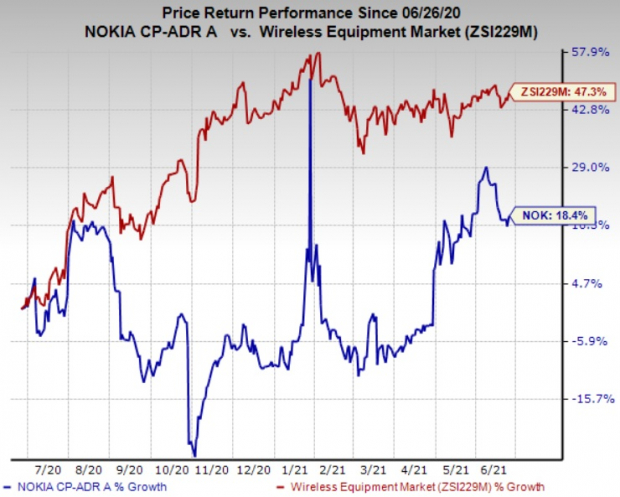Nokia Corporation
NOK
recently extended its AirScale 5G portfolio with the global launch of an improved range of products powered by the ReefShark technology. The new breed of products is likely to help operators better address the dynamic needs of consumers with faster speed, greater capacity and seamless connectivity through efficient ‘plug-in’ deployment.
Based on 3GPP 5G New Radio specifications, the ReefShark technology helps to reduce total cost of ownership and offset deployment costs by leveraging AI and ML techniques. While fulfilling architecture-driven network requirements, it boosts baseband compute capacity through plug-in units fitted into the commercially available Nokia AirScale system module. ReefShark-powered chipsets boast more capabilities and functionality in smaller hardware compared to products that use discrete components. This, in turn, lowers operational costs and reduces energy consumption with the chipsets embedding the highest performance standards in massive Multiple Input Multiple Output (mMIMO) antennas, radio and baseband units.
Nokia has introduced this game-changing technology in 32TRX and 64TRX mMIMO antennas and 8T8R remote radio head solutions. Weighing 17 kgs, the 32TRX mMIMO antenna is the lightest of its kind in the industry, simplifying ease of deployment and installation procedure while supporting high RF bandwidths of up to 400 MHz. This makes it ideal for covering fragmented spectrum or network sharing use cases. In addition, the ReefShark-powered plug-in cards boost the capacity by delivering up to eight times more throughput than other available variants in the market. Notably, Nokia’s baseband module can support 90,000 connected users simultaneously and has 84 Gbps throughput, enabling carriers to scale capacity as their 5G business evolves.
By unlocking network efficiencies with common operability, software delivery and increased hardware sharing, Nokia has been able to reduce the total cost of ownership for mobile operators. The company is well positioned for the ongoing technology cycle given the strength of its end-to-end portfolio. Its installed base of high-capacity AirScale product, which enables customers to quickly upgrade to 5G, is growing fast. The company is driving the transition of global enterprises into smart virtual networks by creating a single network for all services, converging mobile and fixed broadband, IP routing and optical networks with the software and services to manage them. Leveraging state-of-the-art technology, Nokia is transforming the way people and things communicate and connect with each other. These include seamless transition to 5G technology, ultra broadband access, IP and Software Defined Networking, cloud applications and Internet of Things.
Nokia’s mmWave portfolio offers a wide range of deployment options, providing operators some flexibility in ensuring service continuity across different business environments. The company is witnessing healthy momentum in its focus areas of software and enterprise, which augurs well for the licensing business. It is poised to benefit from copper and fiber deployments of passive optical networking. It is the only global supplier that is offering O-RAN with commercial 5G Cloud-RAN networks. Nokia intends to accelerate strategy execution, sharpen customer focus and reduce long-term costs to fend off competition. This, in turn, positions it well to achieve sustainable and profitable growth and expand its business into high-growth vertical markets for technology leadership.
The company facilitates its customers to move away from an economy-of-scale network operating model to demand-driven operations by offering easy programmability and flexible automation needed to support dynamic operations, reduce complexity and improve efficiency. Nokia remains focused on building a robust scalable software business and expanding it to structurally attractive enterprise adjacencies. It has inked more than 165 commercial 5G contracts across the globe. The company’s end-to-end portfolio includes products and services for every part of a network, which are helping operators to enable key 5G capabilities, such as network slicing, distributed cloud and industrial IoT. Accelerated strategy execution, sharpened customer focus and reduced long-term costs are expected to position the company as a global leader in the delivery of end-to-end 5G solutions.
The stock has gained 18.4% in the past year compared with the
industry
’s rally of 47.3%.

Image Source: Zacks Investment Research
Nokia currently has a Zacks Rank #2 (Buy). Some other top-ranked stocks in the industry are
Aviat Networks, Inc.
AVNW
,
United States Cellular Corporation
USM
, and
ATN International, Inc.
ATNI
, each carrying a Zacks Rank #2. You can see
the complete list of today’s Zacks #1 Rank (Strong Buy) stocks here
.
Aviat delivered an earnings surprise of 57.3%, on average, in the trailing four quarters.
U.S. Cellular delivered a trailing four-quarter earnings surprise of 123.9%, on average.
ATN International delivered an earnings surprise of 424.2%, on average, in the trailing four quarters.
Infrastructure Stock Boom to Sweep America
A massive push to rebuild the crumbling U.S. infrastructure will soon be underway. It’s bipartisan, urgent, and inevitable. Trillions will be spent. Fortunes will be made.
The only question is “Will you get into the right stocks early when their growth potential is greatest?”
Zacks has released a Special Report to help you do just that, and today it’s free. Discover 7 special companies that look to gain the most from construction and repair to roads, bridges, and buildings, plus cargo hauling and energy transformation on an almost unimaginable scale.
Download FREE: How to Profit from Trillions on Spending for Infrastructure >>
Want the latest recommendations from Zacks Investment Research? Today, you can download 7 Best Stocks for the Next 30 Days.
Click to get this free report



